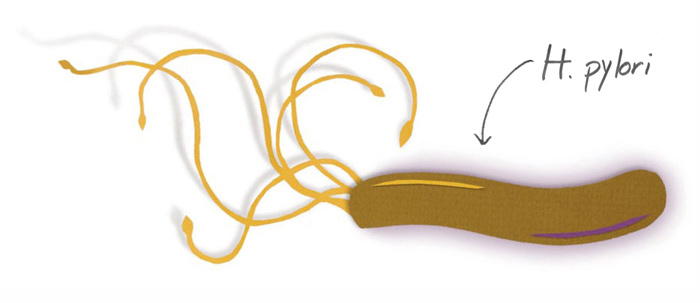Negotiating with Bacteria
|
IF YOU REALLY WANT TO KNOW who you are on the inside, you’ll need a microscope. “We humans are colonized by about 100 trillion organisms in our gut,” says Charles O. Elson, M.D., the Basil Hirschowitz Endowed Chair of Gastroenterology at UAB. “On a gene basis, 90 percent of the genes in our bodies are actually bacterial, so we’re only 10 percent human. And we have only recently begun to think about how that impacts our health.” Even many immunologists are not aware that most of the immune cells in the body are in the intestines, Elson says, “and what they are doing there is managing this complex relationship with our intestinal flora and microbiota.” Most of the time, these relationships are mutually beneficial—we couldn’t digest carbohydrates at all without enzymes contributed by bacteria, Elson points out. So the immune system gives these benign invaders a pass, while violently routing out harmful, food-borne arrivals such as salmonella. “But in some individuals, the immune system is recognizing these harmless partners of ours as dangerous pathogens,” Elson says. “It’s reacting against them and causing tissue damage, and we think that’s what inflammatory bowel disease is all about.” Elson is collaborating with UAB immunologist Casey Weaver, M.D., on a $6.8-million grant from the National Institutes of Health to uncover the processes underlying inflammatory bowel diseases such as colitis and Crohn’s disease. He and Weaver hope their research will reveal a way to turn off the faulty immune response behind these conditions. The current focus area is a newly discovered type of immune cell that was first described in a groundbreaking paper out of Weaver’s lab. In 2005, Weaver’s group documented a new subset of T “helper” cell—a T cell that divides quickly and produces important signaling molecules called cytokines. “For 20 years, scientists studied autoimmune and chronic inflammatory diseases in the context of just two kinds of T helper cells,” Weaver says. “By understanding how this recently identified third type of T helper cell, called Th17, develops and functions in normal and abnormal immunity, we hope to learn how to curb its destructive potential and identify new treatment approaches for autoimmune diseases. This might also lead to new ways to harness the potential of these cells to eradicate certain types of infection and malignancies.” |

Cancer Takes TwoFor decades, hard-charging executives—and nervous workers everywhere—were convinced that the burning stress of their jobs was a quick ticket to an ulcer. But the true cause of most stomach ulcers isn’t deadlines or overdue mortgages: It’s the corkscrew-shaped bacterium Helicobacter pylori. As two Australian scientists discovered in 1982, H. pylori digs through the stomach’s protective layer of mucus and anchors itself to the stomach lining. It then begins to pump out a host of toxins that damage the stomach and intestines, leading to ulcers in 10 to 15 percent of the millions of people who are infected. The damage attracts the attention of a host of immune first-responders, but the body’s assault on H. pylori never succeeds, says Robin G. Lorenz, M.D., Ph.D., professor of pathology at UAB and a scientist in UAB’s Comprehensive Cancer Center and Comprehensive Diabetes Center. In addition to its stomach-destroying toxins, H. pylori secretes chemicals that parry the immune response, allowing it to wreak havoc indefinitely. The body keeps up the attack, however, leading to a state of persistent inflammation. Helicobacter infections are strongly linked to gastric cancer (cancer of the stomach), which kills hundreds of thousands of people worldwide each year, including some 11,000 people in the United States. In fact, H. pylori infection is now considered to be a major risk factor for the disease. The bad bacteria is the initial cause, but it isn’t solely responsible for cancer, says Lorenz, whose laboratory is exploring the H. pylori-cancer link. “It’s very clear that you have to have both the organism and the inflammation in order to get the progression to cancer,” says Lorenz. “In animal models where the T cells and B cells—the cells you need to mount an adaptive immune response—are removed, the animals are infected with Helicobacter, but they never get inflammation and they never get cancer.” The same seems to be true for Crohn’s disease, which is linked to colorectal cancer, and hepatitis, which is linked to liver cancer. Lorenz’s lab has demonstrated in animal models that chronic inflammation damages the protective mucus layer lining the stomach and intestines, which allows bacterial toxins and food-based carcinogens to reach the inner layer and promote tumor development. Some scientists think that over-the-counter anti-inflammatory drugs could have a protective effect against intestinal cancers. A 2009 study published in the British Journal of Cancer that involved more than 300,000 participants reported that regular aspirin users were 36 percent less likely to get a common type of gastric cancer—and that people who took aspirin as little as once per year still had a significantly reduced risk. (People who took other types of NSAIDs had a 32 percent reduction in risk.) The evidence is intriguing, but it is too early to be certain, Lorenz says. “All of these inhibitors dampen the immune response,” she notes. “It could be that they are decreasing the incidence of cancers by decreasing low-level inflammation. The problem is, aspirin and other NSAIDs have many potential mechanisms, so this hasn’t been proven. But there is some evidence.”
|
